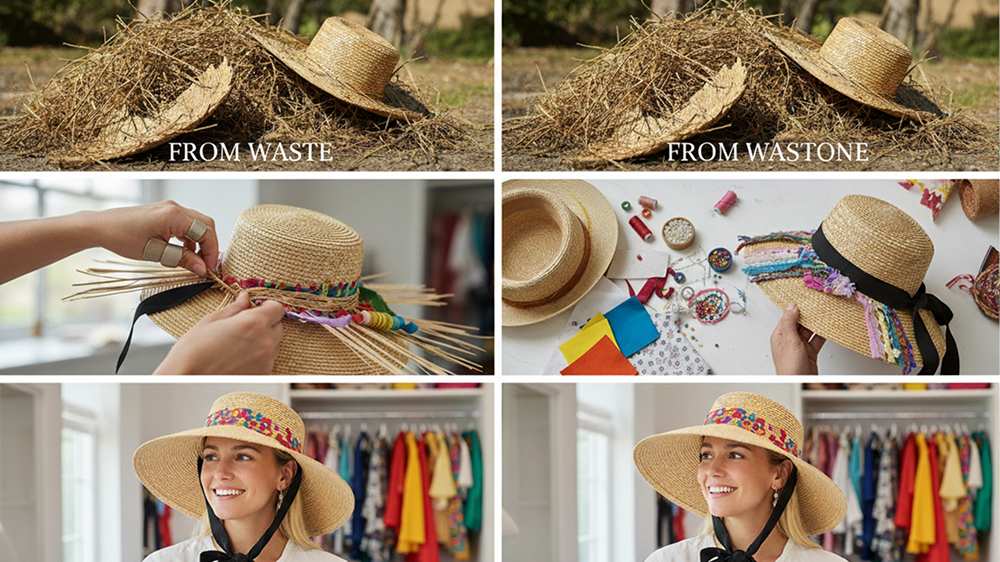These days we all care about the environment, and when it comes to eco-friendly headwear, finding something both stylish and best sustainable hats is now in demand.
Furthermore, a fashionable lid that's gentle on the planet can make a significant impact, proving that looking good and protecting the earth can go hand in hand.
The Need for Eco-Friendly Headwear: Why It Matters
Starting our journey towards sustainability means first picking eco-friendly headwear materials. Moreover, organic cotton is a game-changer here, as it uses a lot less water than regular cotton, as tentree has found out.
Additionally, turning plastic bottles into polyester not only gives those plastics a new purpose but also cuts down on landfill waste.
Consequently, using this recycled polyester in hats is a big step towards redefining what it means to be eco-friendly in fashion.
However, it's not just about the materials. Ethical manufacturing is crucial too. Therefore, making sure factory workers get fair wages and work in safe conditions is just as important.
Meanwhile, sustainable brands that team up with Fair Trade Certified factories show they're serious about caring for both people and the planet.
From Plastic Bottles to Recycled Polyester Headwear
Ever wonder what happens to those plastic bottles you recycle?
Surprisingly, they can end up as cool, eco-friendly headwear like bucket hats and baseball caps.
Initially, the process takes old plastic and breaks it down into tiny bits. Subsequently, these pieces are turned into pellets. Finally, these pellets are spun into threads and woven into eco-friendly hats that are both stylish and durable.
As a result, this journey from waste to fashion shows a promising way forward for sustainable hats. Indeed, you can see how discarded plastics are transformed into new, must-have accessories, reducing your carbon footprint while staying on-trend.
Green Fashion Takes the Spotlight

More and more people are getting into eco-friendly fashion, particularly eco-friendly hats like bucket hats and baseball caps that are both stylish and kind to the Earth.
Furthermore, this trend shows a big shift in how we think about fashion, it's not just about looking good anymore; it's about making choices that help the planet.
Similarly, eco-friendly hat brands are at the forefront of this change, using sustainable materials such as organic cotton and recycled fabrics. Therefore, their work is crucial in reducing waste, minimizing environmental impact, and lowering our carbon footprint.
In addition, from eco-friendly beanies to knit beanies in light brown, these brands are transparent about their production processes and committed to sustainability.
Sustainable Materials to Look Out For:
While the options listed above represent some of the most popular choices for eco-friendly headwear, they're really just the tip of the iceberg.
Additionally, this is an industry buzzing with innovation, so you'll likely find an increasing array of planet-friendly alternatives available.
Top Eco-Friendly Headwear Materials:
- Organic Cotton - Uses significantly less water than conventional cotton
- Recycled Polyester - Made from plastic bottles and reduces landfill waste
- Recycled Wool - Repurposed wool fibers for sustainable warmth
- Tencel - Plant-based fiber that's biodegradable and renewable
- Hemp - Fast-growing, durable material requiring minimal water
- Cork Fabric - Harvested from cork trees without harming them
- Pinatex - Innovative leather alternative made from pineapple leaves
What to Look For When Shopping:
- Certifications from reputable third-party organizations
- Transparency about manufacturing processes
- Information about material sourcing
- Brand commitment to sustainability goals
- Social media presence showcasing ethical practices
Consequently, be sure to do your research before making a purchase. Moreover, consider joining email lists and subscribing to social channels for a look into the manufacturing process.
Spotting Genuine Eco-Friendly Brands: Navigating Certifications and Labels
It's awesome that sustainable options are becoming easier to find, but unfortunately, not all brands claiming to be eco-friendly have the goods to back up those claims.
Indeed, greenwashing,making misleading or unsubstantiated environmental claims, is an unfortunate reality in the fashion industry. However, there are ways to protect yourself.
Third-Party Certifications to the Rescue
A quick and easy way to identify companies committed to sustainability is to look for reputable third-party certifications.
Furthermore, third-party certifications hold companies accountable and help cut through the noise of misleading marketing claims by adhering to strict environmental and social criteria.
| Certification | Focus |
|---|---|
| 🌍 Fair Labor Association (FLA) | Fair Labor Practices |
| 🌟 Fair Trade | Fair Trade Practices |
| 🌱 B Corporation (B Corp) | Social and Environmental Performance |
| ♻️ Global Recycled Standard (GRS) | Recycled Materials |
| 🔬 OEKO-TEX® STANDARD 100 | Chemical Safety |
Go to the certifications on their product pages or “About Us” sections.
Seeing a few familiar logos on a company's website helps assure that the company aligns with your values.
Taking Care of Your Eco-Friendly Headwear: Tips for Longevity
You’ve done your research and carefully selected the perfect eco-friendly headwear. You know sustainable fashion goes beyond making a conscious purchase. The goal is to make things last.
Don’t worry, giving your headwear a bit of TLC can extend its lifespan and reduce its overall environmental impact.
Read those care labels.
Care labels are often ignored, but this handy tag attached to your hat holds a treasure trove of information. Always follow the recommended care instructions on your eco-friendly headwear.
Gentle Washing:
Machine washing might be convenient, but some materials (like wool) are best handled with a gentle hand wash in cool water. Fill a basin with cool water, add a dash of mild detergent, and swish the hat gently.
Rinse thoroughly and avoid any harsh twisting or wringing that could warp its shape.
Air Drying: Keep It Natural
The high heat can shrink and damage certain fabrics. Air-drying might take a bit longer, but it's gentler on the environment and your headwear. Maintaining the hat's shape during the drying process will help prevent stretching.
Conclusion
Finding your new favorite eco-friendly headwear might feel a bit daunting, but trust me, it doesn't have to be hard.
Now that you know a few tricks of the trade, choosing a sustainable and stylish lid will be easier than ever. Moreover, with the growing variety of materials and the increasing number of certified brands, you have more options than ever before.
Ultimately, every eco-friendly headwear purchase is a step towards a more sustainable future, proving that fashion and environmental responsibility can work beautifully together.
FAQs
What makes headwear truly eco-friendly?
Eco-friendly headwear uses sustainable materials like organic cotton or recycled polyester, follows ethical manufacturing practices, and has minimal environmental impact throughout its lifecycle.
How can I tell if a brand is genuinely sustainable or just greenwashing?
Look for third-party certifications like Fair Trade, B Corp, or Global Recycled Standard. Additionally, check if the brand provides transparency about their manufacturing processes and material sourcing.
Is eco-friendly headwear more expensive than regular hats?
While initially eco-friendly headwear may cost more, it often lasts longer due to higher quality materials and construction, making it a better long-term investment.
How do I properly care for my sustainable hat to make it last longer?
Always follow care label instructions, use gentle washing methods with cool water, air dry instead of using high heat, and store properly to maintain shape.
What are the most common sustainable materials used in eco-friendly headwear?
The most popular materials include organic cotton, recycled polyester from plastic bottles, hemp, Tencel, recycled wool, and innovative alternatives like cork fabric and Pinatex.
























